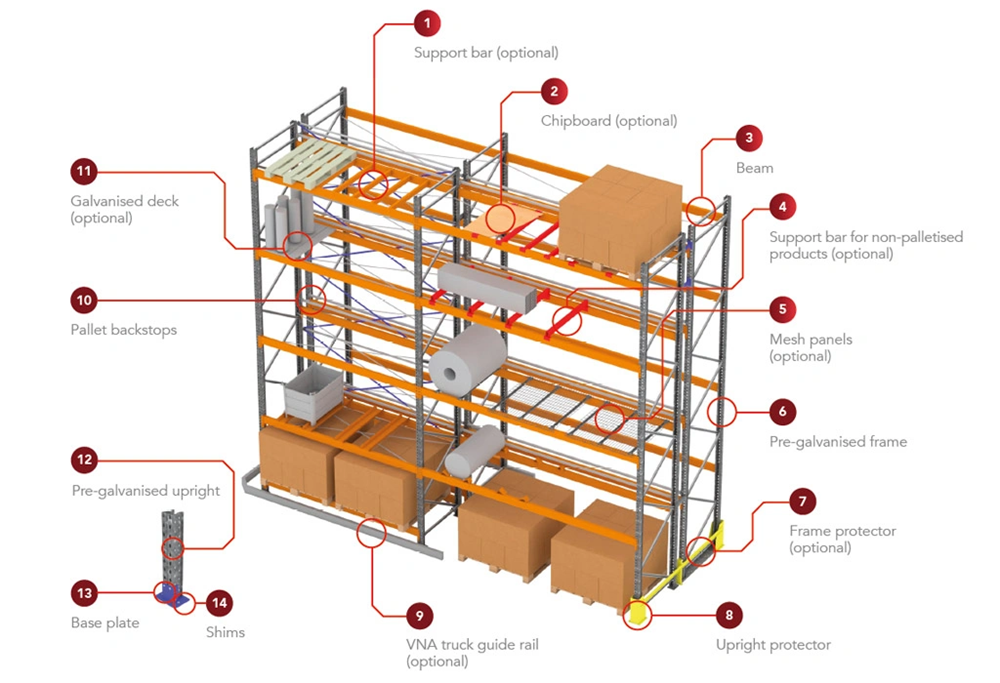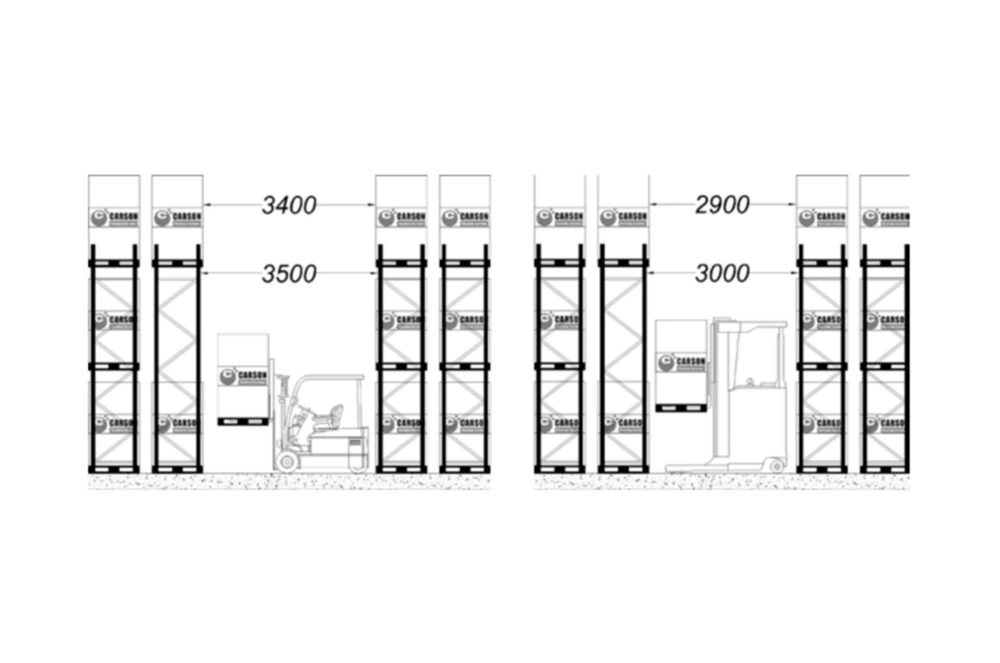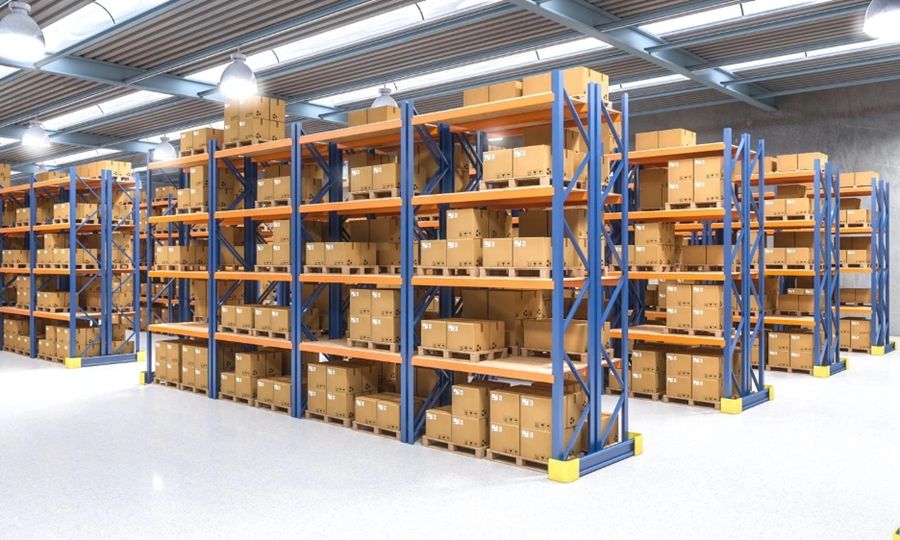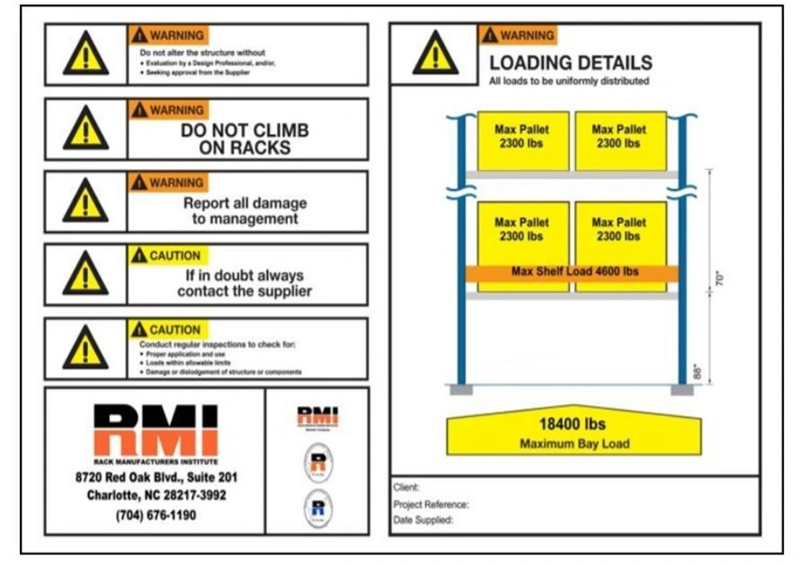
Did you know your warehouse’s operational efficiency depends largely on the type of racking system you choose?
Warehouse racking systems are frameworks that store palletized materials in an organized way that makes them easily available. These systems typically last 10-20 years or more. A well-implemented system can substantially boost operational efficiency, optimize worker safety, and improve inventory management. Selective pallet racks have stayed popular since the 1950s due to their cost-effectiveness and many benefits.
The right warehouse racking layout needs careful thought and planning. Each system comes with different weight capacities – to cite an instance, pallet racks can handle heavier loads compared to cantilever racks. On top of that, it costs more to achieve higher storage density: the denser the storage, the bigger your investment needs to be.
Setting up a new warehouse or optimizing an existing one requires a solid grasp of different racking systems. This knowledge is vital to maximizing space usage while meeting safety requirements. This detailed piece covers everything about warehouse racking types, materials, and load capacities to help you make smart decisions based on your specific needs.
Understanding Warehouse Racking Systems

Modern storage facilities rely on warehouse racking systems that turn static spaces into dynamic, well-laid-out environments. These systems are the lifeblood of maximizing efficiency and creating efficient operations in a variety of industries.
What is a warehouse racking system?
A warehouse racking system optimizes storage space through strategic placement of racks, shelves, or pallets. The simple pallet rack storage system uses upright columns connected by horizontal steel beams to support palletized products. Manufacturers can make these components from structural steel or roll-formed steel. Structural steel provides greater load capacities.
The modular design makes warehouse racking systems versatile. Companies can customize them based on their storage needs. These frameworks help businesses use vertical space effectively, especially when warehouse ceilings are high. The modular nature lets companies add storage capacity or change configurations as their needs grow.
Most systems need material handling equipment, like forklifts, to retrieve pallets. The specific requirements change based on the system type. Today’s racking systems naturally work with warehouse management software and provide vital data points and performance indicators.
Why racking systems matter in inventory management
Successful warehousing operations depend on effective inventory management, and racking systems help achieve this goal in several ways. These systems can double, triple, or quadruple the storage capacity in a given area.
Good racking systems combined with advanced inventory management software make tracking and management easier. Managers can see stock levels and locations clearly. Industry data shows that labor costs make up 70% of total operating expenses for many companies. A well-designed racking system cuts these costs by reducing time spent on searching, picking, loading, and unloading inventory.
The systems offer many more operational benefits:
- Quick retrieval and accurate inventory counts through better access
- Safe operations with less clutter and proper product storage
- Systematic inventory storage through better organization
- Proper inventory flow and prevention of obsolescence through effective stock rotation
Common use cases across industries
Warehouse racking systems serve the needs of various industries. The retail sector leads in adoption, with products ranging from footwear and clothing to cosmetics, medicine, and stationery. This wide use shows how these systems can handle different types of products.
Manufacturing facilities use racking systems to store raw materials and finished products efficiently. These systems often connect with production workflows. Food and beverage companies find great value in systems that support First-In-First-Out (FIFO) inventory management for perishable goods.
Other industries that rely on warehouse racking include:
- E-commerce operations that need fast order fulfillment
- Pharmaceutical companies with strict inventory control needs
- Packaging businesses that handle various product sizes
- Distribution centers managing high-volume throughput
The choice of racking systems shapes operational efficiency in these sectors. Companies need to think about access requirements, inventory rotation needs, storage density goals, and space optimization. The right warehouse racking system leads to business success through better warehouse operations and inventory management.
Types of Racking Systems in Warehouses

The right racking system can make a huge difference in warehouse efficiency. Each warehouse needs a unique solution based on how quickly products move, space limitations, and the types of items stored.
Selective pallet racking
Selective pallet racking is the most versatile storage solution in warehouses today. The system lets you access any pallet without moving others, which works great for businesses with different products and varying turnover rates. Since its introduction in the 1950s, selective racking has become a top choice because it’s cost-effective and brings many benefits.
The design features vertical frames and horizontal load beams that create rows and aisles most forklifts can use. These racks are easy to put together, simple to reconfigure, and give you complete access to all stored items. However, selective racks need more floor space because of multiple aisles and don’t store as much as other systems.
Drive-in and drive-through racking
Drive-in and drive-through racking systems save space by getting rid of aisles. Forklifts can drive straight into these high-density racks to handle pallets.
These systems differ in how you access them. Drive-in racks work on a Last-In, First-Out (LIFO) principle with one entry point, which suits similar products that don’t move quickly. Drive-through racks use a First-In, First-Out (FIFO) method with access from both sides, perfect for perishables that need careful rotation.
You can store up to 75% more compared to selective racks with these systems. The downside is limited access to individual pallets and a higher risk of forklift damage.
Push-back and pallet flow racking
Push-back racking is a space-saving solution where pallets sit on slightly tilted carts or rails. New pallets push existing ones deeper into the rack. This LIFO system can hold 2-6 pallets deep while keeping access from just one aisle.
Pallet flow racks use gravity-powered rollers that move pallets from the loading side to the picking area. This FIFO system works best for perishables or products with expiration dates. You can store up to 20 pallets deep, which cuts down on restocking needs for fast-moving items.
Both options keep forklifts out of the racking structure, which reduces damage risk.
Cantilever and carton flow racking
Cantilever racking’s open-front design has no vertical obstacles, making it perfect for long, bulky items like lumber, pipes, furniture, and steel bars. The system combines bases, upright columns, arms, and braces to give you endless height, width, and capacity options.
These racks come in roll-formed (lighter duty) or structural steel (heavy duty) versions and free up floor space by storing products above ground. They make loading and unloading irregular items easy with clear access.
Carton flow racking, also called a carton live system, works best for smaller, lightweight items that need frequent picking. Gravity-powered rollers or wheels automatically push products forward as items leave the front. This design makes handling easier, improves picking accuracy, and maximizes space.
Double-deep and mobile racking systems
Double-deep racking doubles your storage space by putting two selective rack rows back-to-back, which you can reach from one aisle. This setup stores 20-40% more than standard selective racking. The catch is you need special equipment, like telescopic forks or pantograph mechanisms, to get pallets from the back.
Mobile racking systems put regular racks on moving bases that roll on floor-embedded tracks. These systems create just one movable aisle as needed instead of fixed ones, which saves lots of space. The electronic operation makes them great for cold storage, where smaller cooling volumes cut energy costs [11].
Planning Your Warehouse Racking Layout

A well-planned warehouse racking layout needs careful planning and exact measurements. The right layout helps you store more while keeping operations smooth throughout your facility.
Measuring space and ceiling height
Making the best use of vertical space starts with knowing your key measurements. Warehouses from the 1970s had clear heights of just 16 feet. Modern facilities now reach 32-36 feet or more. Your racking system needs two crucial measurements: the deck height from floor to roof and the clear height from floor to the lowest obstruction.
You need 18-24 inches between stored items and sprinkler deflectors to meet NFPA 13 standards. The total tier height comes from: Pallet Height + Load Height + Beam Height + Clearance Height. Most beams are about 5 inches tall – a detail you must include in your total rack height calculations.
Aisle width and forklift compatibility
Your aisle width shapes both storage density and how forklifts move around. Standard counterbalance forklifts need wide aisles of 10-12+ feet. Reach trucks or stand-up counterbalance forklifts work in narrow aisles of 8-10 feet and boost storage capacity by 20-25%. Specialized equipment like turret trucks can work in very narrow aisles of 5-7 feet, increasing capacity by 40-50%.
You can find the minimum aisle width through: Forklift Clearance + Load Width + Pallet Overhang. Your forklift’s turning radius and lift height should guide your final layout decisions.
SKU velocity and product placement
SKU velocity shows how often items move from their storage spots. ABC analysis helps sort inventory into three groups: “A” items make up the top 50% of orders, “B” items the next 25%, and “C” items the final 25%.
Products that move quickly should sit near dispatch areas to cut travel distance. This strategic placement cuts picking times by up to 37%. Medium-velocity items need spots with good access, while slow-moving items can go to outer areas.
Optimizing for pick paths and safety
Better pick paths cut labor costs and boost productivity. Long rack rows save more money than short, broken layouts that increase costs and reduce storage space. Clear picking routes with minimal backtracking speed up order fulfillment.
Safety must come first in layout planning. OSHA reports that five out of every 100 full-time warehouse workers get injured each year. Your racking systems must support your product weight, and floors must handle fully-loaded racks.
Testing your design makes sense before installation. Mark your proposed racks with tape on the warehouse floor and run through workflows to spot problems. This hands-on approach helps check aisle clearance and rack access before final installation.
Materials Used in Warehouse Racks

Material choices for warehouse racks play a crucial role in their durability, safety, and affordability throughout their service life. Smart selection means finding the right balance between upfront costs and long-term performance.
Steel vs. aluminum vs. wood
Warehouse racks typically use two types of steel: cold-formed (roll-formed) and structural steel. Cold-formed steel comes from rolling sheet steel into shapes and works great for lighter-duty applications as a cost-effective option. Structural steel costs more and weighs more, but it handles heavier loads and stands up better to damage.
Aluminum racking costs more upfront but naturally resists corrosion—a valuable feature in humid environments and food storage facilities. The material’s light weight makes moving and setting up easier, though it can’t bear as much weight as steel.
Wood-based racks seem budget-friendly at first, but struggle with heavy items. These racks face a unique challenge – they soak up moisture and become weaker as they go through wet-dry cycles, unlike their metal counterparts.
Coatings and corrosion resistance
Warehouse racks come with four main protective finishes: paint, powder coating, galvanized, and zinc plating. Paint serves as the cheapest option and works well in regular warehouses, but chips off easily. Powder coating resists scratches better and lasts longer, making it a good fit for food processing facilities.
Hot-dipped galvanized coating creates the best rust and corrosion protection by forming a chemical bond with steel that keeps protecting even after scratches appear. Zinc plating doesn’t protect as well as galvanizing but still fights corrosion effectively.
Durability and maintenance needs
Material choice shapes how much maintenance racks need throughout their life. Galvanized steel racks can last 35-50 years with minimal upkeep. Pressure-treated wood tells a different story – manufacturers claim 40-year lifespans, but these racks often give out after just 9 years.
Steel needs special anti-corrosion treatments in humid spaces, which adds to long-term costs. Aluminum shines here because its natural corrosion resistance eliminates these ongoing expenses, making it cost-effective despite the higher purchase price.
Warehouse Rack Weight Capacity and Load Safety

Safety is the top priority when figuring out warehouse rack weight capacity. A rack collapse can lead to serious injuries, lost inventory, and business disruptions.
How to calculate load capacity
You need a systematic approach to determine the right load capacity:
- Identify the total weight per pallet by combining product weight and pallet weight
- Multiply by the number of pallets per level
- Add the weight of accessories like wire mesh or solid panels
- Divide by the number of beams per level
- Verify the deflection range falls within manufacturer specifications (typically 1/180 of beam length)
The beam capacity drops as span length grows. A beam that holds 5,000 pounds across an 8-foot span might only support 2,500 pounds across 12 feet.
Factors affecting weight limits
Several vital elements shape warehouse rack weight capacity:
Weight distribution leads the list. Uneven loading creates stress points that can trigger structural failures. The vertical beam spacing directly affects load-bearing capacity – wider spacing means lower capacity.
Material quality shapes durability, especially the steel grade, thickness, and manufacturing process. The warehouse floor construction plays a big role, too. Weak floors can crack under heavy loads.
Safety accessories and compliance
OSHA requires businesses to display maximum safe load limits clearly in storage areas. Many safety accessories help protect racks from damage:
Floor-mounted column protectors guard uprights from forklift impacts. Steel guardrails offer visible protection for rack ends. Pallet load stops keep products from falling off racks and create proper flue space for fire suppression.
Inspection and maintenance tips
Regular inspections are the lifeblood of effective rack maintenance. Look for bent beams – they signal that racks are stressed beyond their limits.
Keep an eye on rust and corrosion, especially in humid environments, as they weaken structural integrity. Detailed records of problems, damages, and repairs help track maintenance costs and spot areas for improvement.
Note that proper staff training on rack usage, including staying within recommended capacity limits, helps prevent accidents and extends rack life.
Conclusion
The right warehouse racking system is a vital decision that will affect your operation’s efficiency, safety, and storage capacity for years. This piece explores different racking types that offer unique benefits for specific storage needs. Selective pallet racking lets you access everything easily. Push-back and flow systems help maximize density for certain inventory types. The choice between steel, aluminum, or wood affects both your original investment and maintenance costs by a lot.
Your warehouse’s efficiency depends on how well you use the space. You need exact measurements of available dimensions, ceiling heights, and aisle widths before installing any racks. SKU velocity analysis helps optimize the layout by putting fast-moving products where they’re easy to reach.
Safety should be your top priority when choosing warehouse racks. The right load capacity calculations, proper installation, and regular maintenance help prevent rack failures that could be catastrophic. Your business needs proper safety accessories and consistent inspection protocols to keep both your team and inventory safe.
The best warehouse racking solution strikes a balance between current budget limits and future operational needs. Look at your inventory’s specific traits, handling equipment, and workflow patterns before you pick a system. A well-designed racking layout cuts labor costs, reduces product damage, and creates a safer workspace for your team.
Note that the warehouse needs to change with time. Flexible systems that adapt to changing inventory profiles are a great way to future-proof your operation. With good planning, setup, and upkeep, your warehouse racking system will be the foundation of smooth operations for decades.
Key Takeaways
Understanding warehouse racking systems is essential for maximizing storage efficiency, ensuring safety, and optimizing operational costs in any storage facility.
• Choose racking type based on inventory needs: Selective racks offer universal access, while drive-in systems maximize density for homogeneous products with low turnover rates.
• Calculate load capacity systematically: Add product weight, pallet weight, and accessories, then divide by beam count while ensuring deflection stays within manufacturer specifications.
• Plan layout with equipment compatibility: Match aisle widths to forklift types—narrow aisles (8-10 feet) can increase storage capacity by 20-25% with proper equipment.
• Prioritize steel over alternatives for durability: Steel racks with galvanized coating last 35-50 years versus wood’s typical 9-year lifespan, making steel more cost-effective long-term.
• Implement ABC analysis for product placement: Position fast-moving “A” items near dispatch areas to reduce picking times by up to 37% and improve operational efficiency.
Proper warehouse racking selection requires balancing immediate costs against long-term performance needs. Regular inspections, load limit compliance, and strategic layout planning create safer working environments while maximizing storage capacity and operational efficiency for decades of reliable service.
FAQs
Q1. How do I determine the weight capacity of warehouse racking? To calculate load capacity, add the total weight per pallet (product + pallet weight), multiply by the number of pallets per level, add accessory weights, and divide by the number of beams per level. Ensure the deflection falls within manufacturer specifications, typically 1/180 of the beam length.
Q2. What is the typical load capacity of a warehouse rack? A standard pallet rack compartment can usually hold two pallets, each weighing 2,000 lbs, for a total capacity of 4,000 lbs. However, actual capacity varies based on rack type, material, and configuration.
Q3. What are the OSHA requirements for warehouse racking? OSHA mandates that warehouse racks must support the maximum intended load and be labeled with their load capacity. Employers must post maximum safe load limits visibly in storage areas. Racks should be designed, installed, and maintained to ensure structural integrity under load.
Q4. What are some common types of warehouse racks? Common warehouse rack types include selective pallet racking, drive-in, and drive-through racking, push-back and pallet flow racking, cantilever racking for long items, and mobile racking systems. Each type offers specific advantages for different storage needs and product characteristics.
Q5. How can I optimize my warehouse racking layout? Optimize your layout by measuring available space and ceiling height, matching aisle widths to forklift types, implementing ABC analysis for product placement, and designing clear pick paths. Position fast-moving items near dispatch areas, use narrow aisles where possible, and test layouts before installation to ensure efficiency and safety.

